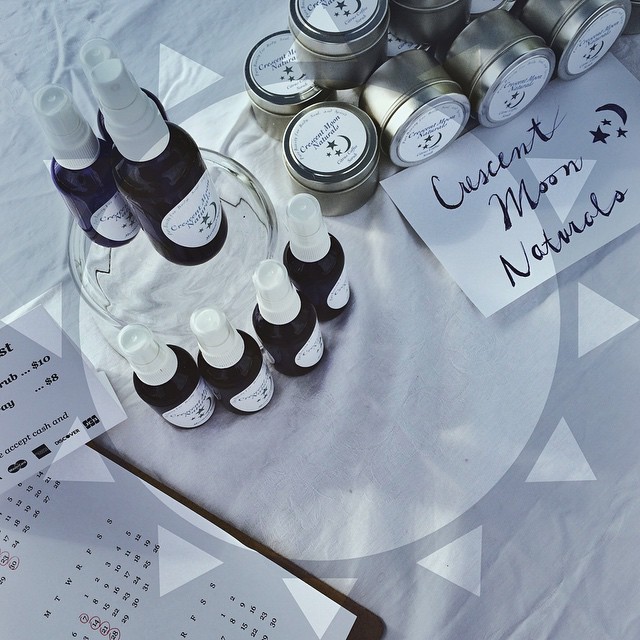Down & Dirty with Toxins
/

I've been away this week as you can see. I was preparing for my first farmer's market selling my all natural beauty product line, Crescent Moon Naturals, namely my citrus body scrub and mermaid sea salt spray-- coming to my online shop soon(!). Woohoo! So in honor of my new weekly commitment, I thought I'd share with you my beauty manifesto and some quick tips on the dirty dozen chemicals that can be in everything from your lotion to your antiperspirant.
+ let me know what you think of these toxins after you read, in the comments below or on facebook!
The Dirt on Toxic Chemicals
Today, we are so far removed from what we put on our skin, what we choose to eat and digest, and what is in our environment. Our largest and fastest growing organ is our skin, and daily, we cover almost every inch with harmful, toxic chemicals found in our lotions, our perfumes, and our beauty products. With all of the press about eating organic, locally grown, non-gmo, etc., we forget that what we put on our skin matters just as much. 60 percent of what we put on our skin is directly absorbed into our bloodstream. That means that the perfumes, lotions, and foundations we put on our skin, those ingredients that are hard to pronounce and don’t resemble something even slightly familiar, directly enters our bloodstream, our source of life.
In fact, the FDA has not evaluated 89 percent of 10,500 ingredients used in our personal care products.
The US federal government doesn’t require health studies to be conducted on personal care products. In fact, the FDA has not evaluated 89 percent of 10,500 ingredients used in our personal care products. To make that a little more clear, that is 9,345 ingredients that go untested and not studied that we willingly slather all over our bodies. Many cosmetics are thought to contain carcinogens and reproductive toxins. One in eight of the ingredients used in personal care products are industrial chemicals; “many products include plasticizers (chemicals that keep concrete soft), degreasers (used to get grime off auto parts), and surfactants (they reduce surface tension in water, like in paint and inks)”1.
Scientists refer to the worst chemical additives as the dirty dozen. At the bottom of the page, I have listed the twelve chemicals. Resources has more information on each ingredient. It is amazing that such toxic chemicals can be added to our everyday routine without our knowledge.
And when we do learn, the current market has failed at producing products that won’t kill us. It seems that nurturing our body and caring for it has backfired, as the things we buy marked “nature’s best” or “all-natural” contain just as many harmful ingredients as the next product. We live in a world where we want to see something so beautifully concocted and presented that we separate ourselves from the trauma it causes our internal system. These toxins kill. Why don’t we listen to that? When you put products on that contain these toxins, you are feeding your body chemicals that will leave you far from beautiful.
These toxins kill.
I understand that it is a hard shift; product lasts a little shorter; they cost more than drug-store buys; they might not be as vibrant or expressive as common brands. And I understand that it is a transition. You add a toxin free product, one at a time, until you find your cabinet filled with products where you can pronounce the entire ingredient list and understand the reasoning behind each ingredient.
This is a relationship with yourself that is worth nurturing. Take care of your body and your body will in turn take care of itself.
The Dirty Dozen
- BHA & BHT used in moisturizers and makeups as preservatives. BHA can cause cancer and disrupts the endocrine system.
- Coal Tar Dyes: p-phenylenediamine // colors listed as “CI” followed by a five digit number often contaminated with heavy metals and aluminum compounds which are toxic to the brain, can cause blindness if comes in contact with the eye
- DEA-related ingredients: look for related chemicals MEA and TEA found in creamy and foaming products, they can react to form nitrosamine, which causes cancer
- Dibutyl Phthalate reproductive toxicant; endocrine disruptor
- Formaldehyde-releasing preservatives look for DMDM hydantoin, diazolidinyl urea, imidazolidinyl urea, methenamine and quarternium-15
- Parabens endocrine disrupters; interferes with male reproductive functions
- Parfum (a.k.a fragrance) ~ thousands of ingredients disguised by this name even exists in “unscented” product; can trigger allergies and asthma; linked to cancer and neurotoxicity
- PEG compounds Used in cosmetic cream bases that can be contaminated with 1- and 4-dioxane, which is linked to cancer; look for related: propylene glycol and ingredients with letters “eth” (i.e. polyethylene glycol)
- Petrolatum a petroleum product contaminated with hydrocarbons used for shine and in lip balms
- Siloxanes found in ingredients ending in –siloxane or –methicone: reproductive toxicant (cyclotetrasiloxane) and suspected endocrine disrupter
- Sodium laureth sulfate; related chemical sodium lauryl sulfate and those ending in “eth” can be contaminated with 1- and 4-dioxane, which is linked to cancer; found in foaming cosmetics
- Triclosan used in antibacterial cosmetics, such as toothpastes, cleansers, and antiperspirants; endocrine disrupter and contributes to antibiotic resistance in bacteria
- “‘Dirty Dozen’ Cosmetic Chemicals to Avoid.” David Suzuki Foundation. N.p., n.d. Web. 05 July 2014.











